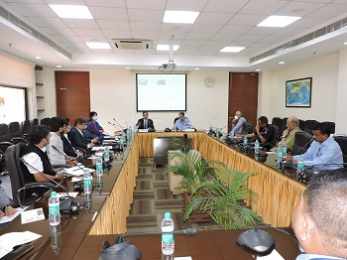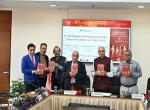By Khusmita Dhabhi & Rishi Gupta
The Vivekananda International Foundation organised a talk by H.E. Dr. Shankar P. Sharma, Ambassador of Nepal on "Nepal-India Relations" on 1st June 2022 at 1100. The session was chaired by Dr. Arvind Gupta, Director, VIF, and moderated by Brig. Vinod Anand. In his welcome remarks, Dr. Gupta said that in the past seven decades, the bilateral ties between the two countries have deepened manifold. His remarks were seconded by H.E. Amb Shankar Sharma.
India and Nepal have originated from the same civilisation, religious beliefs and spiritual values. People to people relations have been strengthened over centuries. As of now in there is alarge-scale religious tourism taking place between the two countries and an open border plays a critical role in it. Although, an estimated 2 lakh Indian tourists visit Nepal, the numbers are way higher as tourists entering Nepal through landroutes are not counted. King Janak, Goddess Sita, Bhagavan Buddha was born in Nepal and lived their lives in India. The shared Hindu and Buddhist heritage have been crucial in spreading the message of peace and love around the world. Indian cinema and music are very popular in Nepal, and kinship and family relations between both countries- rulers and common are well known. India has been the top destination for Nepali students too.
Also, Army to Army relations and defence ties are very strong and around 32,000 soldiers from Nepal are serving in the Gurkha regiment of the Indian Army. An estimated 140,000 Gurkha soldiers are pensioners who have served in the Indian Army. This relationship has been fundamental in modernizing the Nepali Army and in providing the necessary equipment.
On the economic front, the two share an exemplary bonhomie. Petroleum products from India are imported into Nepal. The ties are so deep-rooted that the inflation in Nepal is tied to India because of the paper currency and the open borders between both countries. The shortage of fertilizer is often procured by the Nepali farmers from the border. Nepal is also the ninth-largest export destination for India. The Rupay card has been recently legalized in Nepal and hundreds of thousands of Nepalese come to India for employment.The remittances sent by Nepali workers from India contribute to the mutual development. The bilateral cooperation in drinking water resources and electricity generation is tremendous.
During the recent visit of Indian Prime Minister Modi to Nepal, a Vision Document was released which listed the ongoing hydropower projects and potential of future hydropower cooperation. Now, Nepal has begun to export hydropower to India which speaks for itself. A long-term Free Trade Agreement in terms of electricity with India, flexibility in some quarantine restrictions, and the establishment and mutual recognition of testing labs in the border areas will further improve Nepal’s hydropower capacities as well as strengthen bilateral ties.
The connectivity between the two countries is yet another success story of development. Indian assistance to Nepal has increased recently. Meanwhile, the existing trade deficit with India is almost 90 per cent and it is concerning. Nepal is thinking of expanding its hydro-power capabilities which will reduce the trade deficit. It will not be drastic and sudden but continuity will lead to a further economic boost.
The technological partnership and support in agriculture are important. Nepal is an agricultural country. However, the import of fruits and grains from India is increasing because of Nepal’s economic profile as it cannot afford a vast array of subsidies on agricultural products like India. Also, an increased investment, especially in the Special Economic Zone- whether it is for import substitution or export promotion would help Nepal’s economic growth. Today, 30 per cent of investment in Nepal is from India. With the hydroelectricity MOUs, this might increase soon. Nepal would also like to see a spill-over impact from India in the manufacturing and IT sector.
Amb. Sharma pointed out that, Nepal is having problems in project implementation due to challenges in land acquisition and environmental clearances, and low capital expenditure in the country. It is negatively impacting some bilateral projects. This can be helped with the closer monitoring of issues. Also, improving the understanding of the two countries’ perspectives is important. One of the areas could be scholarships. The Government of India can increase seats for Nepalese students and offer more scholarships which will impact the future development of relationships between both countries. India’s two programmes namely Neighbourhood First Policy Programme and GenNext Scholarship Programme are good steps in this regard. There should be frequent engagements between journalists and retired diplomats from both sides.
To strengthen future bilateral ties, people-to-people relations must be championed where cinema, music, language, medical and commercial aspects will play a major role. India has become the pharmacy of the world and with the pandemic, its ease of doing business has improved to 63rd rank in 2022. Nepal is trying to replicate India’s foreign investment route within its borders. India’s international confidence has improved and it has become a key geopolitical player. Amb. Sharma noted that “this is the best time to bring the Nepal-India relationship to a new height”.







Post new comment